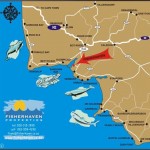Bot River Estuary – Should we interfere?
- Feb
- 08
HOW THE BOT RIVER ESTUARY FUNCTIONS AS A PHYSICAL SYSTEM
The key to understanding how the estuary functions are to look at the way water levels and salinities change with time after an artificial opening. The estuary is usually opened towards the end of winter (the rainy season) when the water level is high. A massive drop in the level of the water occurs immediately the mouth is opened. However, the artificially created mouth only stays open for about six weeks because the net outflow from the estuary is insufficient to wash away the sand deposited in the mouth by the sea. While the mouth is open, the estuary is tidal; seawater penetrates the estuary each high tide, increasing the salinity to a level of about 35 parts per thousand, roughly the same as that of the sea.
During the summer months, very little fresh water enters the estuary but evaporation is considerable and salinities may rise to 40 parts per thousand, while the water level in the estuary continues to drop. With the onset of the winter rains in June, water levels begin to rise and the water in the estuary is gradually diluted with rain and river water. The estuary continues to fill throughout the winter but once it reaches a height of 1.7 metres above sea level, it begins to overflow into the neighbouring Kleinmond Estuary through the Rooisand connection. This overflow is not very efficient and water levels in the Bot may rise as high as 2.8 metres above sea level in a wet winter but the overflow does reduce the water level by about ten centimetres a week once the rain stops The Rooisand connection thus serves to limit the height to which the water can rise in the Bot. It also allows water to be flushed through the Bot and out to the sea via the Kleinmond estuary.
This has two very important consequences for the estuary. The first is that the saline water in the estuary is gradually flushed out of the system. Thus, over a period of four or five years, the salinity in the estuary becomes lower and lower, although there are seasonal variations due to dilution by rainwater and concentration by evaporation that lie superimposed on this general decline. We estimate that after an artificial opening, it will take between three and five years for the Bot river estuary to turn into a freshwater coastal lake, unless the mouth is opened again.
The second consequence is that because the high water-levels are drained off via the overflow, there is little chance that the water in the Bot will reach a level that is high enough to spill naturally over the dunes and break open the mouth. Against all odds there are, however, rare occasions when this does happen. As we
were writing this article flash floods filled the estuary, raising the water level by an astonishing 1.2 metres in about 24 hours and bursting open the mouth. Only three such natural breachings of the mouth have occurred n the last 60 years.
We estimate that it will normally take between 3 and 5 years after an artificial opening for the Bot river estuary to turn into a freshwater coastal lake, unless a natural opening occurs under the exceptional circumstances outlined above. It should be remembered, however, that only three such openings have occurred in the last 60 years.





Recent Posts
- The Pros And Cons Of Solar Power
- 3 Things Private Sellers Wish they Knew (That Estate Agents Do!)
- Top 5 Tips For Sellers in a Buyers’ Market
- Top 5 Tips For Buyers In A Buyers’ Market
- Your Property Title Deed – A Short History
Contact Us
Fisherhaven Properties
Frans Theunissen
Tel: 082 559 4290
Tel: 028 315 1990
Fax: 086 660 4823
info@fisherhaven.co.za

Please ask us about long-term property rentals in the area.


